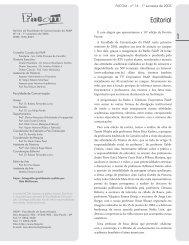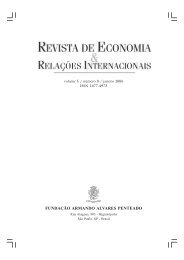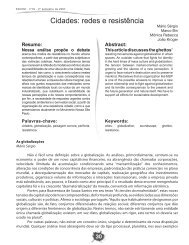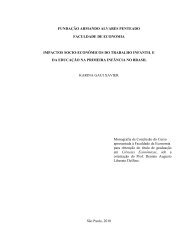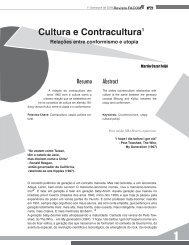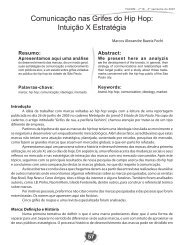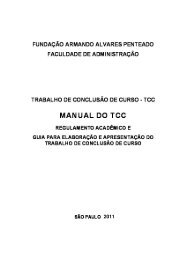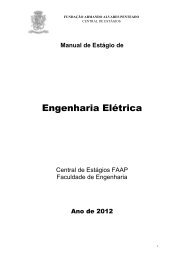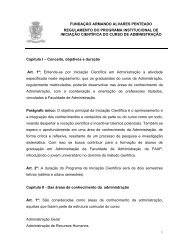GUIA DE ESTUDOS / STUDY GUIDE / GUIA DE ESTUDIOS - Faap
GUIA DE ESTUDOS / STUDY GUIDE / GUIA DE ESTUDIOS - Faap
GUIA DE ESTUDOS / STUDY GUIDE / GUIA DE ESTUDIOS - Faap
Create successful ePaper yourself
Turn your PDF publications into a flip-book with our unique Google optimized e-Paper software.
Previous judicial decisions are a good type of source as<br />
they show in which way a Tribunal tends do decide. Judicial<br />
decisions, also known as jurisprudence, contain<br />
the relation between the cases and decisions made<br />
by Tribunals. Teachings of qualified specialists are also<br />
called doctrine, and are the positions of people that<br />
understand the subject they are referring, in this case,<br />
international public law.<br />
The Statute named a few sources that can be applied<br />
to the cases submitted to the Court, but as mentioned<br />
before, the article is merely exemplificative, and therefore,<br />
other sources may be used to decide disputes between<br />
States, such as decisions of International Organizations.<br />
The Statue was written many years ago (1946),<br />
at a time when International Organizations were not<br />
as important as they are today. This is the main reason<br />
why this source of International Law is mot listed in the<br />
Statute. Nowadays, the decisions of International Organizations<br />
are extremely important. 32<br />
There is a divergence on whether the decisions of International<br />
Organizations are truly valid to be adopted<br />
as an International Law source. 33 No rules or principles<br />
have been written to solve the matter, so it is up to<br />
each person, judge, Tribunal, International Courts to<br />
decide whether to use these decisions or not.<br />
Legal Precedents of the ICJ<br />
The International Court of Justice is the most important<br />
judicial organ of the United Nations and it has already<br />
ruled over important and controversial matters.<br />
States submit their cases and the Court has to reach<br />
a decision on such case. The ICJ may decide legal disputes<br />
between States (contentious cases) or give an<br />
opinion on a matter (advisory opinion). 34 Either so, the<br />
Court’s work is of great importance and always has the<br />
best intentions of the international community and international<br />
law when attempting to solve issues in a<br />
peaceful manner.<br />
One very interesting case in which an advisory opinion<br />
was requested was the “Legality of the Threat or Use<br />
of Nuclear Weapons”, 35 submitted to the Court by the<br />
United Nations General Assembly (GA). In 1996 the<br />
Court reached an opinion based on the question sub-<br />
84<br />
VIII Fórum FAAP de Discussão Estudantil – 2012<br />
mitted and so, it handed down its advisory opinion towards<br />
that matter. The Court replied that:<br />
a. Unanimously, There is in neither customary nor<br />
conventional international law any specific authorization<br />
of the threat or use of nuclear weapons;<br />
b. By eleven votes to three, There is in neither<br />
customary nor conventional international law any<br />
comprehensive and universal prohibition of the<br />
threat or use of nuclear weapons as such;<br />
c. Unanimously, A threat or use of force by means<br />
of nuclear weapons that is contrary to Article 2,<br />
paragraph 4, of the United Nations Charter and<br />
that fails to meet al1 the requirements of Article 51,<br />
is unlawful;<br />
d. Unanimously, A threat or use of nuclear weapons<br />
should also be compatible with the requirements of<br />
the international law applicable in armed conflict,<br />
particularly those of the principles and rules of international<br />
humanitarian law, as well as with specific<br />
obligations under treaties and other undertakings<br />
which expressly deal with nuclear weapons;<br />
e. By seven votes to seven, by the President’s casting<br />
vote, It follows from the above-mentioned requirements<br />
that the threat or use of nuclear weapons<br />
would generally be contrary to the rules of<br />
international law applicable in armed conflict, and<br />
in particular the principles and rules of humanitarian<br />
law; However, in view of the current state of international<br />
law, and of the elements of fact at its<br />
disposal, the Court cannot conclude definitively<br />
whether the threat or use of nuclear weapons<br />
would be lawful or unlawful in an extreme circumstance<br />
of self-defence, in which the very survival of<br />
a State would be at stake;<br />
f. Unanimously, There exists an obligation to pursue<br />
in good faith and bring to a conclusion negotiations<br />
leading to nuclear disarmament in al1 its aspects<br />
under strict and effective international control.” 36<br />
A contentious case that has become quite known<br />
around the world is the “Avena and Other Mexican Nationals”,<br />
37 a conflict matter between Mexico and the<br />
United States of America. The Mexican State instituted






